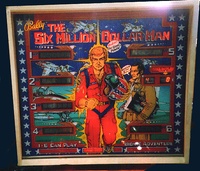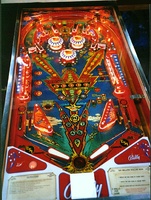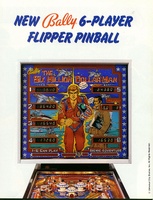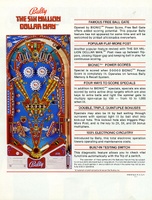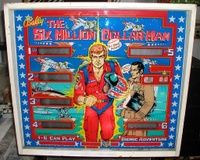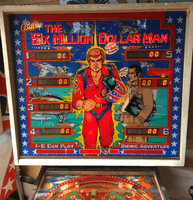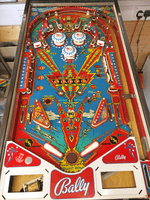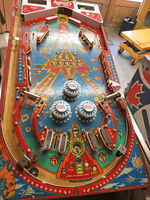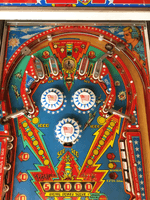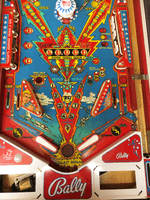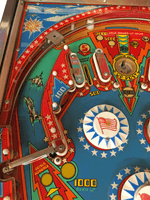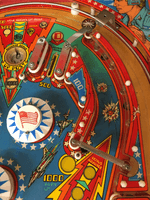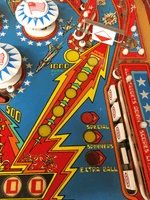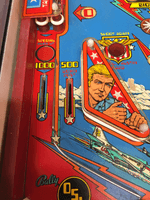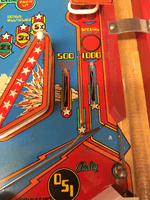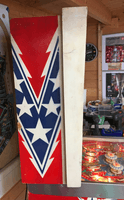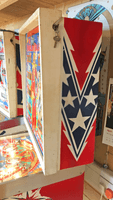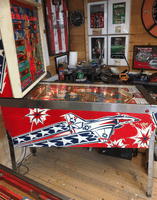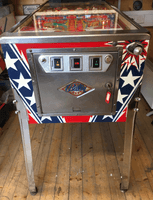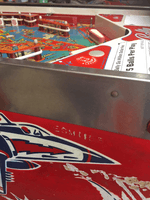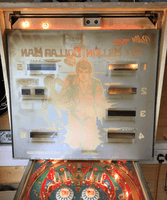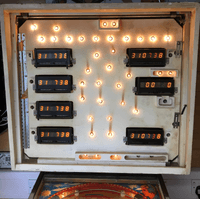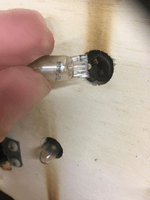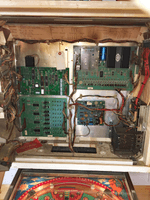
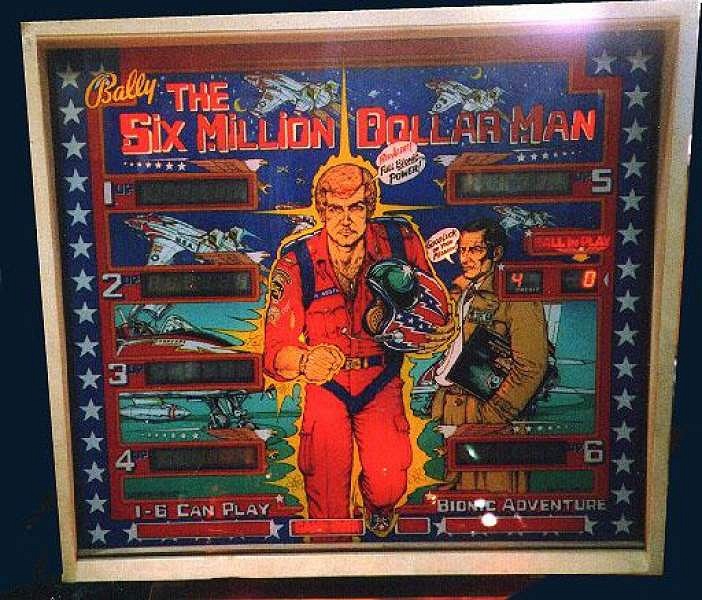
Six Million Dollar Man
We had heard the original name of this game was 'City Slicker' and asked designer Greg Kmiec about it. He replied:I did use the name "City Slicker" on the 1978 whitewood. Back then, the designers named the whitewoods whatever they wanted to and I always liked the name "City Slicker." I got the name from a 1970's contemporary clothing store named "City Slicker" here in the Chicago area. But also remember that during the 1970's, the whitewood names were always changed by the Marketing Department once the game was released for artwork. I was rolling out hit games back then. Tom Nieman obtained the license for "The Six Million Dollar Man" and the "City Slicker" whitewood played so well that the whitewood was chosen to be the next license game and the artwork assignment was given to Dave Christensen. Bally wanted to extend the Kmiec-Christensen magic first exhibited on "Wizard" and "Capt. Fantastic." Bally was transferring to 7-digit displays just then, so the decision was made to use up all of the existing 6-digit displays in inventory by making The Six Million Dollar Man game a six-player game. The game sold quite well for its time. We note that this production run of over 10,000 games would have used up over 20,000 6-digit score displays for players 5 and 6. Bally's first production game with 7-digit displays was Bally's 1980 'Skateball', roughly dated as having occurred seventeen pinball games after Six Million Dollar Man. This production run used aluminum bayonet sockets and #44 bulbs which have a brass bayonet base. However, pictured in this listing is a game with serial number ESM1153 with factory-installed wedge sockets and #444 wedge bulbs. Because we know that Bally's first game to use wedge sockets (and #555 bulbs) in production was Bally's 1981 'Eight Ball Deluxe', we asked Allan Reizman, Engineering Lab Supervisor at Bally from 1977 to 1983, about this. He identified ESM1153 as one the test games in the production run intended to trial the wedge-style lamps. He explains: As everyone knows the #44 bulb was the standard at the time, however the brass content of the base was getting expensive. We're talking just pennies but when you purchase millions of them a year it adds up. At the time, circa 1978, the available wedge base bulb substitute for the #44 was #444. Supposedly, the 44 and 444 were electrically identical except for the base. I hand built a prototype game in the old basement lab, then we went ahead and ran a pilot run of about 100 games with the wedge sockets and 444 bulbs. These were run in the factory so the games should look professionally wired and not modified after the fact. The sockets used would be a firm black plastic win encased connections. If I saw a close-up of the underside of the playfield I could confirm. All the games but one are factory wired and should look like they were built that way. My single hand built lab game would not appear quite as professional but the black sockets will give them away as they are expensive and if somebody wanted to retrofit they would probably use a less expensive socket. My hand built game would have a serial number of 1001 through 1010. That was the numbering convention we used for lab games, I think. I tested a 444 bulb game side by side with a regular 44 bulb game in the factory lunchroom. Brightness was the same as was reliability of the lamps. Management approved the switch in upcoming production. First we had to use up about a million of the awful bayonet sockets and 44s. Somewhere along the line GE came to us with an alternative bulb, the #555. They claimed it was less expensive to manufacture. Again, maybe 1/2 a penny but it made sense considering the high volumes. Before I could test it our purchasing department placed orders for millions of bulbs and sockets for the 555. When the games started coming out I was amused at the cheaper sockets that had been ordered. While I tested and approved parts, the purchasing department would, from time to time, go rogue and order cheaper substitute parts. The first complaint was the new sockets had sharp metal edges that would cut the hands and fingers of the factory workers. You can just imagine reaching into a bulk box of those sockets with bare hands and scooping them out and handling them as they were installed on the playfield. One line worker told me it was like handling razor blades! But the biggest problem was yet to come. I started noticing the switched lamps were failing rapidly on the games in the showroom. Lamps that were pulsed frequently in attract mode were dying in less than a month. Distributors were calling too and complaining the failure rate of the 555 playfield lamps was high. Finally, I ran a test on games equipped with 555 vs 444 vs 44 and the tests showed the 555 bulbs where inherently defective. We ran through 4 or 5 different runs across 3 or 4 game productions before GE finally corrected the problems. That is why there are different bead colors in the 555 bulbs. The bead color designated the batch so we could tell the runs apart. We have seen a photograph (not shown here) of a playfield with a dark green background color instead of the familiar blue color as seen in the manufacturer's flyer. If it is Early Production, then we expect its serial number to precede ESM1097 which belongs to the blue playfield Early Production game pictured here. We are seeking your high-resolution photographs of the dark green playfield version and its serial number.
